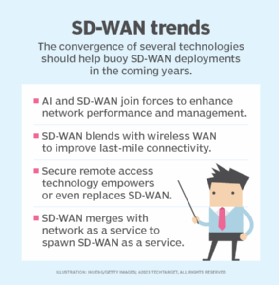4 key SD-WAN trends to watch
Managed services, secure remote access, AI applications and 5G wireless network connectivity are four important trends that should propel the SD-WAN market.
Technologies don't always evolve on their own. Often, customer preferences and the introduction of other innovations help spur the original technology forward, sparking new trends. Software-defined WAN is one example.
For instance, the early adopters of SD-WAN, beset by hard-to-solve WAN problems, deployed DIY SD-WAN. However, that approach became less popular as enterprises now prefer managed SD-WAN deployments. Advancements in AI, cloud, remote work, 5G and wireless technologies have also helped propel SD-WAN adoption.
SD-WAN is the modern backbone of a distributed enterprise, but how it's delivered and used continue to evolve. Moving forward, network professionals should pay attention to the following SD-WAN trends:
- SD-WAN as a service.
- SD-WAN and secure remote access.
- AI in SD-WAN.
- SD-WAN and wireless WAN (WWAN).
1. SD-WAN as a service
SD-WAN migration is a logical place for many IT shops to flip the outsourcing switch and leave the self-managed WAN business entirely. More than half of all SD-WAN deployments now involve managed SD-WAN rather than in-house deployment.
This article is part of
What is SD-WAN (software-defined WAN)? Ultimate guide
Every managed network service provider has multiple SD-WAN options. Offerings range from managed deployments of the same DIY technology an enterprise might deploy on its own to carrier-specific offerings built around the carrier's own network infrastructure and services.
The ultimate version of a managed WAN is a network as a service (NaaS) option. Most NaaS providers deliver the main capabilities of SD-WAN, including redundancy and connectivity choices, as well as policy-driven route optimization and traffic prioritization. Providers have long had similar management, optimization and redundancy features in the middle-mile segments of their architectures, so extending the capabilities to customer locations was straightforward.
In the larger, ongoing shift to anything-as-a-service purchasing, expect to see the appetite for SD-WAN as a service drive broader adoption of full NaaS offerings across industries and for companies of all sizes.
2. SD-WAN and secure remote access
Some secure remote access providers offer options in a cloudlike model. Instead of enterprises managing several VPN appliances at data centers to enable secure remote access to services, they buy the secure connectivity as a service.

Users connect to the nearest point of presence and communicate from there to the data center PoP or cloud provider PoP. Communication occurs across a secured, private middle mile.
In the coming years, two SD-WAN trends should become more visible: combining SD-WAN with secure remote access technology and replacing SD-WAN with secure remote access.
SD-WAN helping power secure remote access
SD-WAN functionality relates to the market category of Secure Access Service Edge (SASE). On one hand, SD-WAN and secure remote access could come together, SASE-style, with increasing frequency.
Personal endpoints for an SD-WAN, whether physical appliances or virtual, can provide the required secure connection from a remote user's location into corporate resources on premises or in the cloud. The SD-WAN does not entirely replace the standard SASE remote access option -- a zero-trust network access (ZTNA) platform -- in most organizations.
Providing an SD-WAN endpoint to every staff member can become unmanageable as the number of staff increases. Some services cannot manage 5,000 sites successfully -- never mind 50,000. ZTNA services do not have that problem and can typically accommodate any number of staff.
Secure remote access replacing SD-WAN
On the other hand, organizations sometimes realize the cloud revolution brings into question the ongoing value and usefulness of the WAN.
With user traffic mostly going to cloud services, the traditional work of the WAN -- moving inside-to-inside traffic among company sites -- now accounts for a quarter or less of typical WAN traffic. Realizing how little of this work remains, organizations question why they should dedicate an expensive network to carry small and decreasing amounts of traffic that typically only matter to a small fraction of sites.
Secure remote access from the endpoints -- whether using a ZTNA platform or a software-defined perimeter (SDP) product -- can meet an increasing number of branch needs. A growing number of organizations are, therefore, dropping their traditional WAN or SD-WAN at some or all sites and having staff use secure remote access instead.
So, another SD-WAN trend is secure remote access entirely replacing a traditional WAN or SD-WAN. Secure remote access without the headaches of a legacy VPN -- whether using a service edge or an SDP product running across the public internet -- could meet an increasing number of worker and company needs.
3. AI in SD-WAN
AI has come to some SD-WAN services. Expect more on-premises and service-based SD-WAN offerings to be infused with AI. In addition to using AI to better optimize traffic path selection, SD-WAN services can use AI to help organizations develop better policy definitions, provide virtual assistant troubleshooting help, and produce smarter performance and security monitoring.
The promise, stated or implied, is that AI applications simplify network management for enterprises and service providers. Network professionals have to judge that for themselves, product by product, as they evaluate and deploy services. Network professionals' level of trust in AI in network automation is likely to trend upward more slowly than the availability of AI-powered SD-WANs.
4. SD-WAN and WWAN
Expect to see huge increases in the use of wireless links for last-mile connectivity within an SD-WAN.
Thanks to SD-WAN, 4G and 5G services are included in more branch network architectures. Some drivers for combining WWAN and SD-WAN include the following:
- Implementing path diversity with the same carrier used for wired links.
- Creating carrier diversity.
- Providing initial connectivity while waiting for wired links to come in.
- Providing failover connectivity.
- Replacing aging and poorly maintained low-speed copper links, such as T1s.
- Avoiding the cost of having good physical links pulled to a new site.
In situations where WWAN isn't the only form of connectivity, SD-WAN enables policy-based control of how to use the WWAN service. In situations where only WWAN exists, SD-WAN can balance traffic across multiple providers, move traffic from an overloaded service to a less loaded one and perform traffic conditioning to improve quality of service.
As 5G standalone services spread in the U.S., implementing WWAN with SD-WAN should get easier and more attractive, at least in 5G areas.
Editor's note: This article was updated to reflect advancements in SD-WAN trends.
John Burke is CTO and principal research analyst with Nemertes Research. With nearly two decades of technology experience, he has worked at all levels of IT. His focus areas include AI, cloud, networking, infrastructure, automation and cybersecurity.








